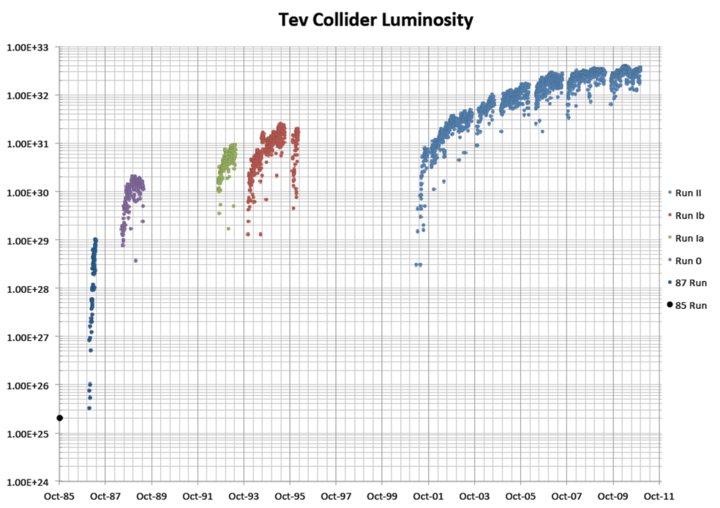Before I paste below the plot in question, let me discuss what it is about. The Tevatron collider has operated since October 1985 -about a couple of geological eras back, in particle physics terms. The W and Z bosons were newborn babies back then, the top quark was thought to have a mass in the 30-50 GeV ballpark, and, to paraphrase the Rolling Stones, "Carlo Rubbia raged and the bodies stunk".
Quite a long road it has been. After 1985 (see here for a recollection of the night when the first proton-antiproton collisions were produced in CDF, by Giorgio Chiarelli, research director of INFN) the Tevatron was operated in Run 0 (1987-88), when four inverse picobarns of collisions were recorded by CDF, and a single clean top-quark-pair candidate was recorded, generating a huge controversy when some members of the collaboration tried to publish independently a kinematic analysis.

Then, in Run 1a (1992-93, in green) the CDF detector operated with a silicon detector in its core, and managed to reconstruct the secondary vertices produced by the decay of long-lived B hadron inside hadronic jets produced by top quark decays. A first evidence of the top quark was published in 1994 by CDF, based on 19 inverse picobarns of data. The cross section was estimated twice as high as is now known to be (a common effect the first time a new particle is spotted), but the mass was measured spot-on at 174 GeV - a result which is less than one standard deviation away from today's world average, when the uncertainty has shrunk tenfold!
In Run 1b (1994-95, in red) CDF was flanked by DZERO, a new detector sitting 120 degrees away along the beam circumference. DZERO had been designed to measure with high precision the W boson mass using electrons, and did not feature a solenoidal magnetic field, nor a silicon microvertex detector: this made it inferior in the top quark search. Despite the shortcomings, the two experiments published the top quark discovery together, in 1995 (when DZERO's mass measurement was way off at 199 GeV, but let uns not stress this fact too much).
Then, Run 1c in 1996 terminated the Tevatron operations at 1.8 TeV of centre-of-mass energy. A qwhole new set of preaccelerators, storage rings, and injection system were built to increase the capability of the Tevatron to produce higher rates of collisions; the detectors were also upgraded substantially. CDF completely changed its inner tracking and enlarged its muon system; DZERO was endowed with a magnet and a performant silicon tracker.
The rest is rather recent history: starting in 2000 the Tevatron has gradually increased the intensity of protons and antiprotons, reaching instantaneous luminosities that exceeded expectations. This was the result of painstaking work at the antiproton source and the implementation of electron beam cooling. A true success.
The data produced by the Tevatron has granted precision measurements of top quark physics, the best W mass measurement in the world, an exclusion of large swaths of parameter space of new physics theories, as well as mass values for the Higgs boson. B physics measurements have shown that hadron collisions may compete and surpass electron-positron machines in selected results, and have provided the measurement of Bs oscillation parameters and CP violation information. New mesons and baryons have been discovered; new effects have been claimed. The legacy of CDF and DZERO is enormous.
And all this is not over yet. Although the Tevatron will shut down at the end of Fiscal Year 2011, the physicists working for the two experiments will continue to analyze the data, improving the measurement techniques and producing new challenging results, which the LHC experiments will find hard to improve on.
I wish to congratulate with the beams division of Fermilab for this incredible quarter of a century of achievements. I, for one, have highly benefited from their work. Outstanding job, folks!



Comments